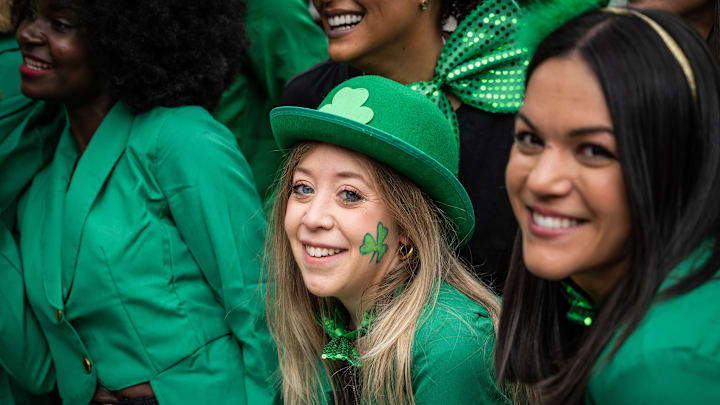St. Patrick’s Day is fast approaching on Sunday, March 17. And with the holiday comes a dull panic as you rifle through your closet to try and find green clothes so you don’t get pinched. But as you do rediscover those old green sweats and sweatshirt, you might be wondering: why do we wear green on St. Patrick’s Day? And also: why do we get pinched?
The answer is actually pretty simple on all counts, as well as what colors you should not wear on St. Patrick’s Day. So let’s get into it.
Why do we wear green on St. Patrick’s Day? Sorry, Indiana Jones, but it didn’t have to be snakes:
One would think that the reason we wear green on St. Patrick’s Day is because that was St. Patrick’s signature color. Not so! While St. Patrick was a real person, and a real saint, there is a lot of myth and misinformation that’s grown around him over the centuries.
The first is you’ve probably heard about why he became a Saint, right? For driving the snakes out of Ireland? That must be why we associate green with him, because he’s… Wearing snakeskin suits or something like that? Well, no. In fact, snakes are not native to Ireland, and so therefore St. Patrick did not drive them out.
In fact, St. Patrick was sainted for a much more banal reason: he brought Christianity to Ireland. That’s pretty much it!
…and beyond that, in early paintings of St. Patrick, he was mostly clad in blue, not green. So why green then?
St. Patrick used a three-leaf clover to explain Christianity

There are a number of possible reasons for the green, including that Ireland is known as the Emerald Isle for its green hills. But the most likely is that St. Patrick was associated with the three-leaf clover, as he used it to explain the father, the son and the holy spirit, aka three pillars of Christianity.
Since the three-leaf clover is green, and St. Patrick is associated with the three-leaf clover, that may be a reason the holiday is associated with wearing green clothing.
Further adding fuel to this theory, green became the national color of Ireland in the 18th century when the clover became the national symbol. But there’s a bigger reason here that ties into Irish independence.
Green is the color of Irish protest against the English
In the late 1700s, King George III further compounded the association between St. Patrick – who, of note, was born in Britain – and the color blue, by making it the official color of the Order of St. Patrick.
Perhaps as a sign of protest, around the same time the Irish adopted green as their color, and would wear a shamrock on St. Patrick’s Day to show their own devotion to the Saint – in clear defiance of the English.
What color should you not wear on St. Patrick’s Day?
Well, blue is a color you should not wear, for one. But the tradition of wearing green didn’t really start until Irish immigrants in America began wearing the color to associate themselves with their home country. If you head to Ireland, you’ll certainly see people wearing green; but it’s not as big of a deal as it is here in the United States.
Short version: you can wear whatever color you want, nothing is actually out of bounds.
Why do you get pinched on St. Patrick’s Day?

Rumor has it that leprechauns love to pinch people – but if you’re wearing green you’re invisible to a leprechaun. However, as you might be able to gather from the rest of this explainer, this is not something that has anything to do with St. Patrick, and possibly not even Ireland.
Given green – and leprechauns – weren’t associated with the Saint, and wearing green isn’t a big deal for Ireland unless the whole country loves the feeling of getting pinched by mythical creatures chances are this is something American, as well.
Though there’s no specific start for the whole pinching thing, it’s clear that it’s a folk tale that developed over time to perhaps retroactively explain the whole wearing-green thing. Plus, it’s just fun to pinch people to punish them for not wearing green, gotta be honest.
Regardless, you will probably get pinched if you don’t wear green on St. Patrick’s Day in America. Anywhere else? You’re good to put on that snakeskin suit you’ve been dying to try out. Just maybe avoid the blue.
Got questions about history, trivia, or anything else? Send an email to askeverest@fansided.com and we might answer here on the site!
